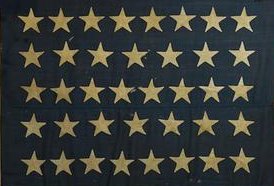A Step Back in Time: The Civil War
Here at The Great Republic, we embrace the tradition and history of the United States of America through the display and sale of various forms of media. One of the oldest time periods that we are honored to represent is the Civil War era (1861-1865), arguably one of the most influential periods in the United States’ history. Today, two pieces from The Great Republic’s old collection are highlighted to portray the way American ancestors have shaped the world for generations to come.
Any American student is taught about the significance of the battle of Gettysburg in the illustrious American Civil War at a young age. Fought from the 1st of July thorough the 3rd in 1863, this battle will forever be known as the great turning point of the Civil War. One of the most influential artists of the time period, Peter F. Rothermel, was commissioned by the state of Pennsylvania to represent the battle of Gettysburg in 1866. Rothermel dove deep into his work, visiting the battlefield multiple times before completing the painting. Rothermel’s completed battle scene of Gettysburg, now hung in the state museum in Harrisburg, was a painted representation of the spirit of the Union in the fight against the Confederacy and injustice. This piece is entitled The Battle of Gettysburg. Some years later in 1872, a well-known artist by the name of John Sartain artistically recreated Rothermel’s painting as an engraving. This is the work pictured below, which hangs proudly in the CityCenter DC shop (Figure 1).

John Sartain was an immigrant to America, originally hailing from London, United Kingdom. He was skilled in engraving and also held precedence in the publishing world after settling in Philadelphia. He took on the Union Magazine and later adjusted its title to reflect his shared ownership of the periodical, entitling it Sartain’s Union Magazine. Sartain, as an immigrant and artisan, was well established in the professional world of 19th century Pennsylvania, and was even a colleague and friend to poet Edgar Allan Poe.
Sartain’s The Battle of Gettysburg Engraving depicts the repulse of Confederate General Pickett's charge by Union soldiers. On the third day of the battle, fighting had resumed on Culp's Hill, and cavalry battles raged to the east and south. However, the main event was a dramatic infantry assault by 12,500 Confederate soldiers against the center of the Union line on Cemetery ridge, known as Pickett's Charge. The charge was repulsed by Union rifle and artillery fire, at great loss to the Confederate army.
General Meade, a Union officer and engineer, is best known in history books for his defeat of General Robert E. Lee at Gettysburg. He is depicted to the far left in the composition. He certainly draws the viewers’ attention, with the elaborate gesture of his arm and the enthusiasm with which he flings his hat. Here, Rothermel chose to depict a moment of climax through the rendering of this cluster of figures. Captain George Meade flanks General Meade on his right. To General Meade’s left is Lieutenant Frank Haskell. Haskell's presence in the composition represents the moment of Union victory, in which he informs General Meade that the Confederate forces are being repulsed. This energy is conveyed in Sartain’s engraving, with the hope of Union victory approaching in the future.
While Meade is recognized as a prominent figure in Civil War history, the composition of this piece does not reflect him as the sole hero. Instead, another figure is featured predominantly. This figure centralized in the composition is Private Sills. Sills is a fictional character, fabricated in order to represent the common man—the dedicated, nationalistic civilians whose dedication to their distinctive causes put a flame under the battles of the Civil War. Here, Private Sills can be assumed to be a Union soldier, moments away from victory, and his appearance here was a tribute to those Americans who served in the Civil War.
This celebrated engraving captures the heart of the Civil War, both representationally and figuratively. The Great Republic also offers works of American-made art that were practical forms of nationalistic pride—flags. Pictured below is one of the most striking and rare flags currently on display at The Great Republic at CityCenter (Figure 2). This 36-star flag celebrates the statehood of Nevada, which became a state after being a territory for three years. In October 1864, Nevada was granted statehood, post-Civil War, under the recently established 13th Amendment, abolishing slavery and reuniting the United States in a way never before seen. Thus, Nevada’s statehood was even slightly rushed, in the attempt to reunite the war-stricken country and pass the 13th Amendment with soaring colors. Nevada’s previously insufficient population was granted statehood, and the 36-star flag was flown from 1865-1867, beginning on the official date for flag adjustments, July 4th.

Prior to the Civil War, Americans rarely displayed a flag for personal use. The events of the Civil War, starting even prior to the commencement of the war with the introduction of Kansas into the Union as the 34th state and the election of President Abraham Lincoln in 1861, marked a turning point in both the surge of patriotism and the production and display of the American flag. This 36-star flag was valued then as much as we value it now, for its nationalistic symbolism and remembrance of American values. The 36-star flag was used commonly after the Civil War for celebratory events, as well as in solemn times to mourn the death of President Lincoln.
This flag is stable and in good condition, considering its age and use. The cotton flag has its stars hand-sewn onto both sides. The stripes are also hand-finished on the reverse of the flag, indicating that the flag was most likely hung as a banner. Along the hoist side are period cloth ties, further indicating use as a banner. This flag has six small holes, which bear early repairs. These holes are most likely a result of bad staining during previous storage. The colors are faded but intact, and all 36 stars are still fully attached. The character of this flag is apparent, and recollects the time period honorably.
The events of the American Civil War changed our nation’s dynamics by establishing the unity and civil purpose that we continue to respect today. Either of these pieces, currently displayed in the DC shop, would add a tone of historical understanding to any collection.






